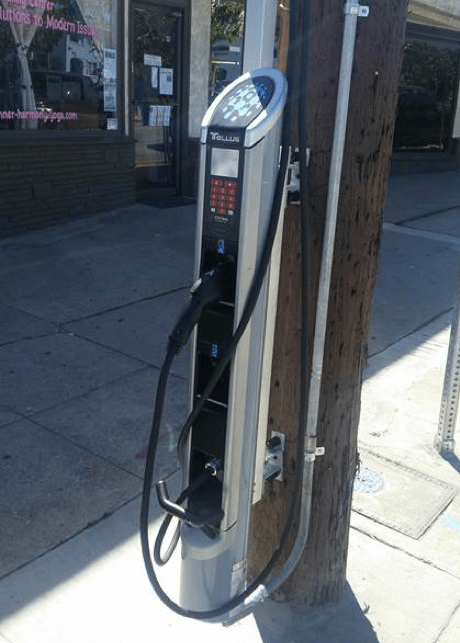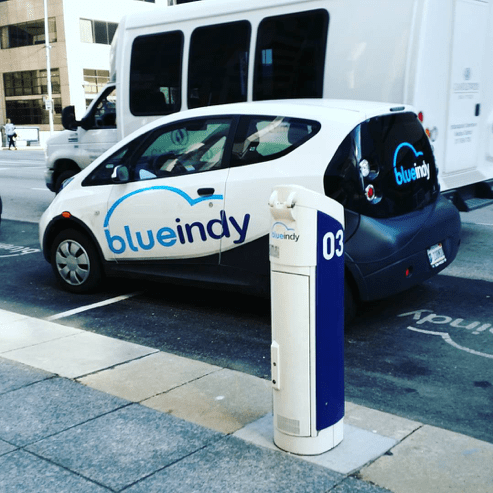Ben Lambert, a 34-year-old who manages fundraising efforts for a number of nonprofits, lives in one of Denver’s densest residential neighborhoods: Capitol Hill. The area surrounds Colorado’s capitol building and is home to museums, concert venues and restaurants. The housing stock consists mostly of apartment buildings and tightly packed homes.
Ben’s apartment building has a small off-street parking area in the alley, with four spots for more than 15 units in the building, so most residents park on the street. He doesn’t own a car currently, but if he needed to buy one, he’d want an electric vehicle (EV). Which raises the question: If Ben did buy an EV, where could he charge it?
It is a question that is coming up with increasing frequency as EVs grow in popularity. Research suggests that only about half of vehicles in the U.S. have a dedicated off-street parking space, like a driveway or garage. In dense areas of cities across the country, residents rely on on-street parking to park their vehicles at home. Studies have also found that most electric vehicle owners prefer to charge at home, with some projections assuming nearly 90 percent of EV charging will happen at home. With more electric cars on the road, and many more coming soon, cities will face the challenge of where electric vehicles will charge, particularly in city centers and neighborhoods without off-street residential parking.

A typical block in Capitol Hill, Denver. Credit: Screenshot of Google Maps
A Political and Technical Challenge
Providing EV charging in dense city neighborhoods brings its own set of challenges. A case in point is Philadelphia, which recently put on hold a 10-year old program that allowed residents to apply for, and install, electric vehicle charging stations near their homes.
By 2017, Philadelphia residents had obtained permits for or installed 67 electric vehicle spots, using just a tiny share of the city’s 43,000 permitted or metered on-street parking spaces, more than 46,000 garage or lot parking spaces, and vast number of free, unmetered spaces.
Despite the program’s limited reach, vocal opponents blamed the program for exacerbating parking shortages in neighborhoods. With large numbers of electric vehicles expected in Philadelphia (and cities around the country) in coming years, closing off opportunities to expand EV charging is heading in exactly the wrong direction.
Innovative Leadership
Fortunately, there are many models of how cities around the world are tackling the urban EV charging problem with innovative solutions to expand access to charging infrastructure, including along public streets.
Recently, Frontier Group and PennEnvironment authored a report, Plugging In: Readying America’s Cities for the Arrival of Electric Vehicles, which highlights some examples, including:
- In London, residents can request that charging stations be installed on their block. A company, Ubitricity, will install EV charging plugs on lampposts on the requested block and send customers a cord to charge their vehicle. Los Angeles is also deploying charging stations on streetlights in the city.
- The New Orleans City Council unanimously passed legislation in September 2017 allowing residents to apply for permits to install electric vehicle charging stations in front of their homes, on public property. Seattle has also started a similar pilot program.
- In the Netherlands, Belgium and Germany, Allego, a private company, partners with municipalities to facilitate installation of chargers in front of people’s homes. The company installs the charger for no cost and bills customers for electricity usage.
- Singapore’s electric carsharing program, which launched in December 2017, plans to make 400 of its charging stations available to all EV drivers needing a charge.
- The city of Utrecht, in the Netherlands, offers strong subsidies for “semi-public” charging stations, which are located on private property but are available for some public use.

An electric vehicle charger on a streetlight in LA. Credit: Los Angeles Bureau of Street Lighting
The Need for a Comprehensive Strategy
In the absence of a comprehensive approach to parking, however, it may be hard for cities to follow the example of EV leaders around the world.
Plugging In argues that expanding shared mobility, electrified public transit, safe biking and walking, and other transportation options – as well as reforms in parking pricing – can reduce competition for on-street parking that might crowd out space for EV charging. These reforms also support the creation of walkable communities where people have a variety of low-carbon and zero-carbon transportation options.
Specific tools include:
Carsharing
One reason for competition over scarce parking is that many people – even residents of cities with transit service – may feel the need to own a car to meet their mobility needs. Since the typical car is parked and idle 95 percent of the time, dependence on privately owned vehicles creates tremendous demand for places to store vehicles.
Expanding access to shared mobility services in dense urban areas has the potential to reduce overall competition for parking, creating the potential to use some on-street spaces for EV charging.

BlueIndy, Indianapolis’ electric carsharing program. Credit: Deb Nystrom via Wikimedia, CC BY 2.0.
Electric Bikesharing
Access to shared bicycles can help address many transportation challenges, particularly when paired with other forms of transit and shared mobility. Electric bicycles make riding a bike even more accessible for the public and can enable more residents to travel without a car.
Rationalizing Parking
By reducing free parking, and by charging more in areas where there is more demand, cities can address the perceived problem of parking scarcity, ensuring that any surplus of existing spaces can be used efficiently, including spaces dedicated for electric vehicles.
Cities Benefit from Encouraging Shared Parking
In this case, private parking lots are used for a variety of purposes. For example, for employee parking during the day and residential parking at night. Shared parking eliminates duplicative parking spaces that are tailored for specific uses, and, if equipped with EV chargers available to the public, can help expand the availability of charging infrastructure as well.
Embracing Opportunities
In the next 10 to 15 years, cities across the U.S. can expect tremendous growth in electric vehicles – with projections estimating that 20 percent of new cars could be electric as soon as 2030.
If cities wish to obtain the environmental, public health, and quality of life benefits of electric vehicles – and meet the needs of their residents – they will need to plan for the dramatic expansion of electric vehicle charging infrastructure, including in residential neighborhoods where off-street parking is limited.
Cities should plan for this transition in the context of an overall mobility transition that encourages the use of public transportation, shared mobility services, bicycling, and walking.
A transition that reduces demand for parking from private vehicles – while creating new charging opportunities for both privately owned and shared electric vehicles – can deliver a powerful “win-win” for cities and help propel America toward a clean, efficient, zero-carbon transportation system.















